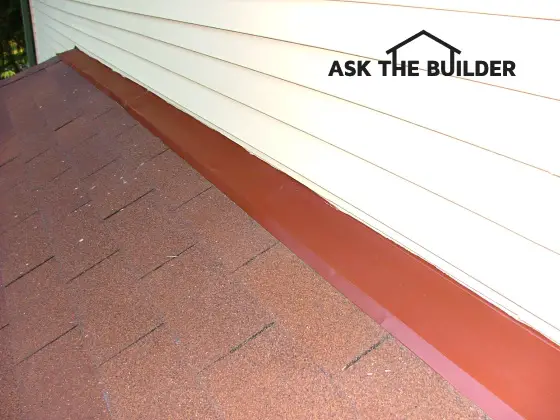Stop Roof Leaks with Flashings

Roof Leak Flashings - A vast majority of all roof leaks are at flashings. This is a base flashing where a lower roof ends against a second-story wall.
Roof Leak Flashings - Yep, That's Where You Look First.
You undoubtedly expect many things when you move into a new home. Fresh paint, trouble-free plumbing, new fixtures and a dry environment are surely high on the list. But you might be surprised how many new homes develop roof leaks in a very short amount of time. Unless you have nerves of steel and a tall ladder, I doubt you'll have the chance to get up and inspect your roof during the walk-through inspection. You might simply hope the roof is okay.
How Can I Inspect My Roof?
It is possible to inspect the roof. You can hire an independent roofer or a certified whole-house inspector to check out things you can't easily see. This individual should have the equipment and the experience to quickly see if the roof and all of its components are installed correctly.
CLICK or TAP HERE to get FREE quotes from local roofers that can inspect your roof and stop leaks.
What is a roof flashing?
A roof flashing is a material that connects your roofing materials to something that's not your roof. Here are examples of things that are not a roof, but have flashings around them or next to them:
- plumbing vent pipes
- chimneys
- exhaust vents from a furnace
- skylights
- dormers
- second-story sidewalls
- valleys
- etc.
What Does a Flashing Look Like?
Watch this video to see the most common flashing there is. Every house has one of these and some houses have more than one:
What Material is Used to Make Flashings?
Flashing material can be made from many things including tin, copper, galvanized steel, lead, aluminum and even rubber. The most common place a homeowner sees flashing is at a plumbing vent pipe. A chimney poking through a roof always has a flashing around it. Skylights always are surrounded by flashings.
Do You Have More Information About Flashings?
Yes. CLICK or TAP HERE to discover more about metal roof flashings.
What is a Counterflashing?
A counterflashing is a secondary material that overlaps a lower flashing that's weaved into the roofing material. You'll find these counterflashings around chimneys and skylights in almost all cases.
Frequently you will see triangular pieces of metal that are actually mortared into the chimney. These are just one part of a complex set of metal pieces that weave into the roofing materials and the masonry chimney to form a watertight connection.
Are Flashings Found Where a Roof Butts Up Against a Wall?
Another common flashing location is anywhere a roof butts up next to a wall. For example, your new home might have a single-story garage connected to a two-story house. Look closely where the shingles touch the house and you should see flashings. If the house has some sort of wood or vinyl siding, these siding materials will lap over the metal flashings. This method of construction produces leak-free performance as well.
CLICK or TAP HERE to get FREE quotes from local roofers that can inspect your roof and stop leaks.
Are Plumbing Vent Flashings Simple?
Plumbing vent pipes also have a simple flashing that slides down over the pipe that sticks up through the roof. Be sure to watch the video above showing how to install a plumbing vent-pipe flashing.
Typically newer flashings of this type are equipped with a special silicone-rubber collar that fits tightly around the circular plumbing vent pipe. This flashing lays over the shingles below the lower half of the flashing and the upper half of the flashing is covered by the roofing shingles above the flashing.
Do Skylights Come With Flashing Kits?
Yes, certain skylights have factory-built flashing kits that are superb when installed according to manufacturers' instructions. Velux was the leader in this area beginning back in the 1970s. In my opinion, Velux skylights come with the best flashings and you'll never have a leak if you follow their installation instructions.
They will keep out the worst driving rain and keep any room leak free. These factory-built flashings require no soldering or caulk to provide years of leak-free performance. I have five of them on my own home and have installed hundreds of others.
What Do You Use To Make Your Own Flashings?
I prefer to use flashing materials that can be soldered easily. Tin-coated steel and copper meet this requirement. Tin-coated steel used to be available in different weights: 20 and 40-pound. The 40-pound tin has more tin coating on the pieces of steel.
However, stringent and oppressive environmental requirements have all but eliminated sources of tin-coated steel in the USA. This is a tragic loss as I feel there's very little solid evidence that the lead is as big an issue as it's made out to be. I'm not trusting of the science behind these restrictions. The old cynic in me thinks that some group or politicians are profiting from these harsh restrictions for a time-tested material used on roofs for centuries.
Understand that the led in the flashings since is not exposed to the atmosphere because all tin flashings are painted. What's more, lead is a natural element found in nature on its own.
Is Copper a Great Flashing Material?
Yes, copper is perhaps the best flashing material. It doesn't require painting, it's easy to bend and form, and it's extremely easy to solder. Copper flashings can last up to 100 years.
You can purchase very thin copper that will protect your asphalt shingles from deteriorating. CLICK or TAP HERE to purchase this thin copper.
I made this discovery when writing my Roofing Ripoff expose' book.
Can I Use Aluminum for Flashing Material?
You can use aluminum for certain flashings. It's a great material for step flashings that weave into shingles.
The biggest issue is that aluminum can't be soldered. Some incompetent roofers will CAULK aluminum flashing, but this is a mistake. Caulk is NOT a flashing material.
Can I Use Aluminum Against Brick or Stone?
No. Never use aluminum in contact with brick or stone.
Be sure your builder does not use aluminum flashing material in contact with any masonry walls or chimneys. The alkaline chemicals in the masonry can corrode the aluminum over time. Aluminum is also very difficult to solder or weld. Beware of roofers or builders who install aluminum and then caulk corners to make a leak-resistant joint. There are no caulks that will provide the same trouble-free performance as solder.
Column NH033
